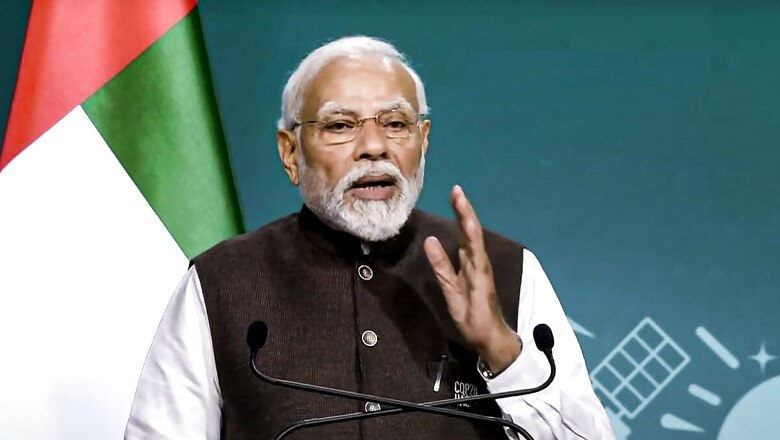
views
A Climate Analytics report, released on Tuesday, highlights Asia’s crucial role in expanding global renewable energy. Currently, driven by India and other Asian nations, Asia contributes the largest share (47 per cent) of additional renewable capacity needed to triple global production by 2030. This target was set at COP28 in Dubai to achieve the Paris Agreement’s 1.5°C warming limit. The report warns that only Asia is “on track” to triple renewables by 2030, with sub-Saharan Africa lagging significantly. It also raises concerns about the simultaneous growth of fossil fuels alongside renewables in India and China, potentially jeopardising the alignment of the power sector with the 1.5°C goal and creating stranded assets.
Meeting the COP28 goals requires a global investment of $2 trillion annually until 2030, totalling $12 trillion. Asia’s share stands at $4.5 trillion by 2030. The report attributes the high concentration of future renewable additions (47 per cent) in Asia to the region’s energy demand and existing fossil fuel capacity. Presently, Asia holds 46 per cent of the world’s fossil fuel capacity and 45 per cent of its renewable capacity. India plays a leading role, expanding its renewables 30 times since 2014 to reach 180 GW, the fourth-highest globally.
By December 2023, renewable energy sources (including large hydropower) boasted a combined installed capacity of 180.79 GW.
The following is the installed capacity for Renewables:
- Wind power: 44.73 GW
- Solar Power: 73.31 GW
- Biomass/Co-generation: 10.2 GW
- Small Hydro Power: 4.98 GW
- Waste To Energy: 0.58 GW
- Large Hydro: 46.88 GW
Due to India’s current policies and renewable energy levels, Asia is the only region that could achieve the capacity needed to maintain the 1.5℃ goal by 2030, with the growth in renewables in India compensating for the relatively lower growth in other Asian countries like South Korea.
India’s Shift to Renewable Energy
India is making significant strides in the global renewable energy sector with a substantial expansion program. Under Modi’s leadership, the nation aims to boost its renewable energy production capacity, setting a target to install 500 GW of renewable energy capacity by 2030.
Harnessing the abundant solar energy resources and leveraging local technological advancements, India is making significant strides towards achieving this momentous goal while concurrently curbing carbon emissions. Modi’s vision of building an Atmanirbhar Bharat, or a self-reliant India, drives this endeavour, ensuring that the nation becomes self-sufficient in meeting its energy demands without reliance on imports.
The transition to solar and wind energy sources marks a pivotal shift away from coal-based generation, while the adoption of electricity-charged batteries reduces dependency on conventional liquid fuels like petrol and diesel. Furthermore, the integration of zero-carbon hydrogen technology holds immense promise in decarbonising India’s industrial landscape, slashing emissions, and diminishing reliance on imported fuels.
In addition to its ambitious targets, India underscores the importance of embracing sustainable lifestyles and advocating for global environmental consciousness. This commitment was underscored during the G20 Summit in September 2023, with the adoption of the New Delhi Declaration, which pledges to implement India’s ‘Lifestyle for Environment Mission’ (LiFE) initiative and champions the role of artificial intelligence (AI) in advancing the UN Sustainable Development Goals.
Modi’s proactive approach extends beyond national borders, as evidenced by his instrumental role in spearheading initiatives such as Mission Innovation (MI) and the International Solar Alliance. Launched at COP21 in 2015, MI, comprising 23 countries and the European Commission, aims to accelerate the global clean energy revolution, aligning with the Paris Agreement’s objectives and pathways to achieve net-zero emissions. As a founding member of Mission Innovation, India has led several pivotal initiatives, including Smart Grids, Off-Grid Access to Electricity, and Sustainable Biofuels, hosting numerous workshops to drive innovation and collaboration in the clean energy sphere.
Policy Initiatives
The Modi government has initiated several policy measures to promote sustainable development in India. These include schemes like the Production Linked Incentives (PLI) for high-efficiency solar PV modules, Renewable Purchase Obligations, and the Carbon Credit Trading Scheme. These efforts signify India’s commitment to environmental stewardship and are contributing to the country’s green growth trajectory.
Highlighting India’s proactive stance on climate action, the formation of the Global Biofuels Alliance (GBA), with India, Brazil, and the United States at its helm, underscores a collective effort to combat climate change. With a focus on biofuel production and consumption, this alliance is poised to play a pivotal role in achieving India’s ambitious goal of attaining net-zero emissions by 2070.
The economic advantages of energy independence are not lost on India, as evidenced by its push towards electric transportation. Projections indicate that this transition could result in a remarkable $2.5 trillion in net consumer savings by 2047, further solidifying the case for sustainable energy solutions.
India’s commitment to innovation in clean energy technologies is evident through initiatives such as the National Hydrogen Energy Mission, aimed at promoting cost-competitive green hydrogen production. Moreover, the country’s holistic approach to energy-mix strategies encompasses a broad shift towards cleaner alternatives, increased manufacturing capacities, and policies supporting hydrogen production.
In addition to technological advancements, India’s long-term Cooling Action Plan (CAP) sets a precedent for sustainable urban development. With a vision spanning two decades, the CAP identifies actionable measures to reduce cooling demand across sectors, emphasising energy-efficient solutions for residential and commercial buildings.
The recent passage of the Anusandhan National Research Foundation (NRF) Bill, 2023, by Parliament, underscores India’s commitment to fostering a culture of research and innovation. With an estimated investment of Rs 50,000 crore over five years, this initiative is set to catalyse clean energy research and support Mission Innovation, with a significant portion of funding sourced from non-governmental entities.
India’s Renewable Journey
India has made remarkable progress in its transition to clean energy, leading the pack with the fastest pace of renewable capacity addition among major economies. Modi articulated ambitious transition goals in India’s Panchamrit declaration at COP26, solidifying India’s commitment to addressing the global challenge of climate change. India stands at the forefront of this effort.
The nation has pledged ambitious Nationally Determined Contributions (NDCs), aiming to reduce emission intensity by 33-35 per cent by 2030 compared to 2005 levels. Over the past nine years, India has demonstrated its dedication to combating climate change, surpassing its commitment to achieving 40 per cent energy production from renewable sources well ahead of the 2030 Paris Agreement target. Moreover, from 2014 to 2023, India has significantly increased its power generation capacity by 70 per cent. The nation has shifted from a power deficit to a surplus, with 97,501.2 MW added in conventional power and 96,282.9 MW in renewable energy during the past decade. As of October 2023, India’s generation capacity has reached 425,536 MW, compared to 248,554 MW in March 2014.
The Ministry of Power has formulated a comprehensive plan to address the projected rise in power demand. This plan includes ongoing construction projects such as 18,033.5 MW of hydro capacity, 8,000 MW of nuclear capacity, and 78,935 MW of renewable energy capacity.
Green Jobs
The Skill Council for Green Jobs (SCGJ) defines ‘green jobs’ as those with a direct positive impact on the environment, contributing to overall environmental welfare. These encompass roles focused on utilising or developing renewable energy, resource conservation, energy efficiency, waste management, and sustainable development.
A recent report by SCGJ and Sattva Consulting, supported by JP Morgan, forecasts that India could generate up to 35 million green jobs by 2047. These opportunities span traditional and emerging sectors, including renewable energy, waste management, electric vehicles, green construction, and sustainable textiles. Solar energy is projected to lead the way, hosting 3.26 million jobs by 2050, with wind energy expected to support 0.18 million jobs by 2030. Additionally, the bioenergy and green hydrogen sectors are anticipated to create 0.27 million and 0.6 million green jobs by 2030, respectively.
According to the International Renewable Energy Agency (IRENA), India boasted approximately 988,000 renewable energy jobs in 2022. Hydropower emerged as the top employer with 466,000 jobs, closely followed by solar photovoltaic (PV) with 282,000 jobs spanning both on-grid and off-grid systems.
Industry leaders foresee immense potential in India’s renewable energy sector, with projections suggesting it could generate 3.5 million jobs by 2030. In the fiscal year 2021-22, over 52,000 individuals were newly employed in India’s solar and wind energy sectors, marking an eightfold increase from the previous fiscal year.
Conclusion
India’s remarkable strides in renewable energy solidify its position as a frontrunner in Asia’s clean energy transition. Under Modi’s leadership, the nation has not only set ambitious targets like achieving 500 GW of renewable capacity by 2030, but has also implemented progressive policies, embraced technological advancements, and fostered green job creation. This multifaceted approach positions India as a leader, not just in its region, but on the global stage.
By tripling its renewable capacity by 2030 and aligning with the Paris Agreement goals, India safeguards its own environmental future while inspiring and guiding neighbouring nations. Embracing sustainable lifestyles and advocating for global environmental consciousness further elevate India’s role as a responsible stakeholder in the fight against climate change. As India continues on its clean energy journey, its success holds immense promise for a more sustainable future for not only its citizens but for the entire planet.
Views expressed in the above piece are personal and solely that of the author. They do not necessarily reflect News18’s views.



















Comments
0 comment